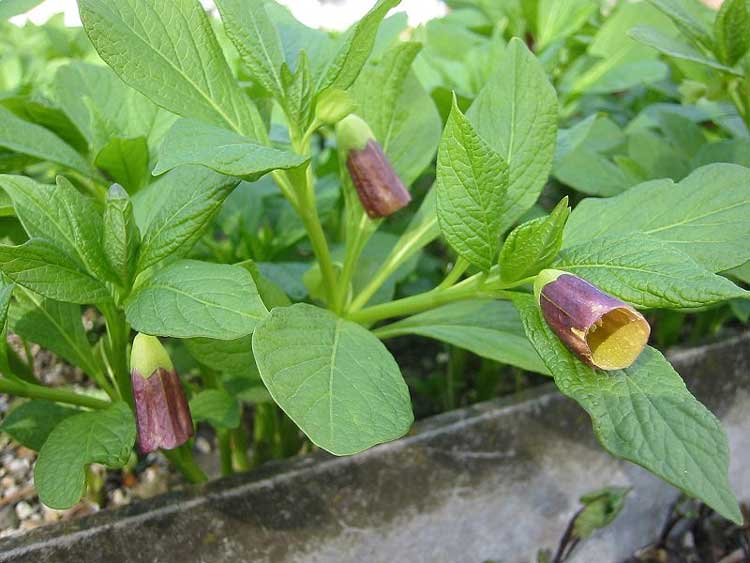
Scopolia carniolica
Classification System: APG IV
Superregnum: Eukaryota
Regnum: Plantae
Cladus: Angiosperms
Cladus: Eudicots
Cladus: Core eudicots
Cladus: Asterids
Cladus: Lamiids
Ordo: Solanales
Familia: Solanaceae
Subfamilia: Solanoideae
Tribus: Hyoscyameae
Genus: Scopolia
Species: Scopolia carniolica
Name
Scopolia carniolica Jacq. (1764)
References
Jacquin, N.J.v. 1764: Observ. Bot. 1: 32.
USDA, ARS, Germplasm Resources Information Network. Scopolia carniolica in the Germplasm Resources Information Network (GRIN), U.S. Department of Agriculture Agricultural Research Service. Accessed: 09-Oct-10.
Vernacular names
azərbaycanca: Karniol skopoliyası
Deutsch: Krainer Tollkraut
English: henbane bell
suomi: Skopolia
Nederlands: klokbilzekruid
polski: Lulecznica kraińska
slovenščina: Kranjska bunika
svenska: Dårört
українська: Скополія карніолійська
Scopolia carniolica, the European scopolia[1] or henbane bell, is a poisonous plant belonging to the family Solanaceae, It has dark violet flowers on long hanging stems. It grows to 60 centimetres (24 in) in height. Its toxicity derives from its high levels of tropane alkaloids, particularly atropine. The concentration of atropine is highest in the roots.
Scopolia carniolica grows on wet soils in beech forests of southeastern Europe from lowlands to the mountainous zones, being native to a region stretching from the eastern Alps to the eastern Carpathians and also naturalised farther east in southwestern Russia.[2] The rare form Scopolia carniolica f. hladnikiana (which differs from the common form in having a corolla that is greenish yellow, both inside and out) is native to Slovenia.
Scopolia carniolica was first described by the botanist Carl Linnaeus and named in honour of the physician Giovanni Antonio Scopoli as Hyoscyamus scopolia. Nikolaus Joseph von Jacquin classified it to the genus Scopolia. The specific name carniolica signifies 'of Carniola', a historical region that comprised parts of modern-day Slovenia (see also Duchy of Carniola and March of Carniola).
Scopolia carniolica is the symbol of the Slovene Society of Anaesthesiology and Intensive Care Medicine. The plant is a source of scopolamine, which was used as an anesthetic in the past.[3][4]
Use in folk medicine and criminal poisoning
The plant was used in the late Middle Ages as a narcotic agent and an ingredient in 'love potions' – a practice frequently resulting in fatal cases of poisoning. Furthermore, in its native Carpathians, Scopolia carniolica was also used with criminal intent, either to stupefy victims in order to rob them, or to kill them outright.[2] It has also been used throughout Europe as a medicinal plant.[5]
References
USDA, NRCS (n.d.). "Scopolia carniolica". The PLANTS Database (plants.usda.gov). Greensboro, North Carolina: National Plant Data Team. Retrieved 8 November 2015.
Starý, František, Poisonous Plants (Hamlyn colour guides) – pub. Paul Hamlyn April, 1984, translated from the Czech by Olga Kuthanová.
Soban, Branko (January 2005). "A Living Bond between Idrija and Uppsala". Slovenija.svet. Slovene Emigrant Association. Retrieved 2007-12-01.
Scopoli, Giovanni Antonio. Joannes A. Scopoli-Carl Linnaeus. Dopisovanje/Correspondence 1760-1775, ed. Darinka Soban. Ljubljana, 2004: Slovene Natural History Society.
Fatur, Karsten (June 2020). ""Hexing Herbs" in Ethnobotanical Perspective: A Historical Review of the Uses of Anticholinergic Solanaceae Plants in Europe". Economic Botany. 74 (2): 140–158. doi:10.1007/s12231-020-09498-w. ISSN 0013-0001.
Retrieved from "http://en.wikipedia.org/"
All text is available under the terms of the GNU Free Documentation License

